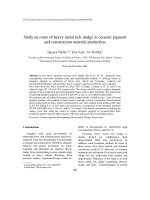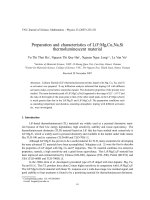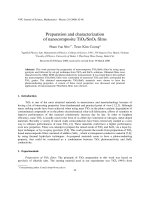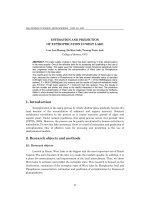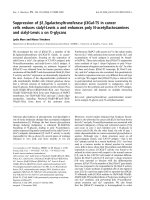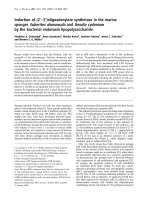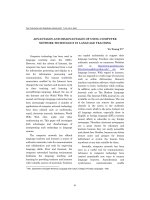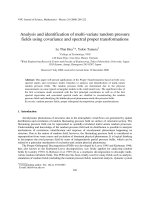Báo cáo " Advantages and disadvantages of using computer network technology in language teaching " pptx
Bạn đang xem bản rút gọn của tài liệu. Xem và tải ngay bản đầy đủ của tài liệu tại đây (128.8 KB, 6 trang )
T¹p chÝ Khoa häc ®hqghn, ngo¹i ng÷, T.xxI, Sè 2, 2005
61
Advantages and disadvantages of using computer
network technology in language teaching
Vu Tuong Vi
(*)
(*)
MA., Department of English-American Language and Culture, College of Foreign Languages - VNU.
Computer technology has been used in
language teaching since the 1980’s.
However, with the advent of Internet, the
computer has been transformed from a tool
for information processing and display to a
tool for information processing and
communication. The instant worldwide
connections enabled by the Internet have
changed the way teachers and learners work
in their teaching and learning of
second/foreign language. Indeed, the use of
the Internet and the World Wide Web in
second and foreign language instruction has
been increasingly recognized. A number of
applications of computer network technology
have been utilized such as multimedia,
email, electronic journals, databases, World
Wide Web, chat, audio and video
conferencing etc. This paper will investigate
both advantages and disadvantages of
incorporating such technology in language
courses.
The computer network has offered
language teachers and learners a source of
authentic materials, tools for communication
and collaboration and tools for improving
language skills. First and foremost, the
computer networked learning environment
facilitates the language teaching and
learning by providing teachers and learners
with valuable sources of materials. Teachers
can exploit multimedia to support their
language teaching. Teachers also integrate
authentic materials on numerous Websites
such as
,
etc
. into
language lessons. With regard to learners,
they are exposed to a wide range of resources
such as online dictionaries, thesauri,
machine translation software, which enables
learners to learn vocabulary while reading.
In addition, quite a few authentic language
journals such as The Modern Language
Journal, The Internet TESL Journal etc. are
available on the net and databases. The use
of the Internet can remove the greatest
obstacle in the access to the authentic
written word, which is the price. Indeed, not
all language students, especially those in
English as foreign language (EFL) contexts
cannot afford to subscribe to any foreign
newspaper. Therefore, electronic newspapers
are a great chance for educators and
learners because they are easily accessible
and almost free. Besides, learners can obtain
lecture notes and prepare for lessons
beforehand or review the lessons from
anywhere at any time suitable for them.
Secondly, computer network has been
seen as a useful tool for communication.
Advances in computer technology have
created remarkable new ways to connect
language learners. Asynchronous and
synchronous communication enable
Vu Tuong Vi
T¹p chÝ Khoa häc §HQGHN, Ngo¹i ng÷, T.XXI, Sè 2, 2005
62
language learners can communicate rapidly
and inexpensively with other language
learners or speakers of the target language
around the world (Warschauer and Healy,
1998). From these kinds of communication,
positive affective benefits for learners are
reported in the foreign language classroom.
In fact, the advantage of computer-
mediated communication (CMC) brought
about by Internet is that learners are given
an opportunity to interact with others
without interruptions, time pressure or
social anxiety. Moreover, the use of
technology redistributes teacher and
classmate attentions so that less able
students can become more active
participants in class.
The on-line environment also enhances
communication between teachers and
learners. Warchauter (1997) explored the
use of email between a teacher and her
students in a graduate of English as second
language (ESL) writing class. He found
that using email enables teacher to
provide students with detailed and
rapid feedback on the immediate
problems and questions they had.
Computer- based communication
technology also provides tools for language
learners to improve their language skills.
Learners are exposed to numerous software
programs to improve their reading, listening,
speaking skills and grammar knowledge .
For example, students in the networked
writing project by Beuvois (1998) display
more fluidity of conversation, more use of
complex sentences, and more self-
disclosure. Lunde (1990) also showed that
Japanese students enrolled in a computer
mediated communication project showed
improvement in reading comprehension.
Besides, learners can use audio- visual
technologies to correct and/or enhance
pronunciation of words in the target
language.
The use of technology in foreign
language learning also appears to influence
the development of communicative skills. In
fact, computers can offer foreign language
learners more than drills; “they can be a
medium of real communication in the target
language, including composing and
exchanging messages with other students in
the classroom or around the world” (Oxford,
1990, p. 79). By involving in an email
exchange with a native speaker, learners
receive plenty of authentic target language
input from their exchange partner while
maintaining the unrehearsed
communicative context.
The network environment also enables a
new form of language learning i.e. distance
learning. Indeed, the Web has created the
capability of opening classroom doors to the
world. Online environments and the use of
the WWW provide students with skills such
as online communication, discussion,
problem analysis, problem solving, critical
thinking and negotiation of meaning.
Distance learning is especially of benefits in
language learning because not everyone can
afford to study abroad and explore the
language cultures. In contrast, with the
application of the Internet and the WWW,
students can attend foreign language classes
from home without having to go to the
country where the target language is
spoken. One of the main reasons for special
interest of foreign language educators in
distance learning is that technology makes it
Advantages and disadvantages of using computer network
T¹p chÝ Khoa häc §HQGHN, Ngo¹i ng÷, T.XXI, Sè 2, 2005
63
possible to bring the target culture into the
classroom and thus, closer to students.
Language learning is a multifaceted
social and cultural phenomenon; therefore,
one of the most essential pedagogical
principles of language teaching is one that
emphasizes the study of language in a
cultural context because language and
culture are inextricable and independent.
Sanaouri and Lapkin (1992) found that in an
email exchange project between these
students and native French speakers,
students assumed increased responsibility
for their learning and broaden their cultural
knowledge. Indeed, virtual trips enabled by
the Internet offer students an opportunity to
visit countries and learn about the people,
language, and culture. Undoubtedly,
understanding the culture of the target
language enhances the understanding of the
language.
However, the discussion would be
incomplete without addressing the
disadvantages or obstacles related to the
issue of using computer network technology
in language teaching and learning in terms
of financial barriers, content considerations,
technical features and pedagogical
perspectives.
The most challenge is the issue of access.
Students must have computer and Internet
access. Therefore, they will meet with
difficulties when technology is not always as
reliable as it should be and Internet access is
not always available. This situation is
commonplace in quite a few English as
foreign language (EFL) contexts. Financial
barriers include the cost of setting up a
network in the school, which can be
expensive.
Financial barriers also include the
investment in training. The use of the
Internet in language teaching and learning
requires some technological knowledge and
computer skills from both teachers and
learners. Insufficient computer skills from
students have affected the quality of online
collaboration of Lee (2004)’s project.
Teachers may be reluctant to use technology
in classroom because many of them have not
been trained to use technology. Others do
not understand how to use the new
technologies. This requires school
investments for training in this area, which
is beyond the current capacity for schools in
EFL contexts.
Moreover, searching for materials on-
line can be sometimes time- consuming and
frustrating. Many learners find it difficult to
read papers on a computer screen. Also, it is
easy to become bombarded with too much
information with little control over the
quality and accuracy the contents.
Therefore, a certain technical expertise is
required from both teachers and students.
More importantly, little is know about how
to make use of Internet- based materials or
how to design tasks that allow the learners
to explore these materials and yield expected
learning outcomes.
There are still limitations on navigation
and hyperlink structures in the networked
learning environment, which can make
learners get lost. Besides, communication on
the Web will be difficult when the network is
slow at peak times. Findings from two pilot
studies by Kotter (2001) which investigated
the use of Internet- based audio
conferencing and email by distance language
learners at the British Open University
show that about one fifth of students
Vu Tuong Vi
T¹p chÝ Khoa häc §HQGHN, Ngo¹i ng÷, T.XXI, Sè 2, 2005
64
dropped out because of technical problems in
terms of the speed of the network and the
reliability of the software.
Another challenge to the use and
implementation of computer- assisted
language learning (CALL) in the foreign
language classroom is the pedagogical
changes. The use of networked computing
environment in second or foreign language
learning will lead to the different ways of
teaching and learning from the traditional
language classrooms. In fact, the nature of
the space of the language learning
environment has undergone a paradigm
shift- from traditional blackboard
classrooms to computer labs- and so the
position as teachers/learners within that
space has changed also. In this environment,
teacher’s role underwent a significant shift
from a knowledge giver to a facilitator. The
students took over the responsibility for
their own language learning and became
more active and more autonomous learners.
The changes in pedagogy, teachers’ and
learners’ roles have implied the difficulties of
the network environment in EFL contexts.
For instance, Conrad (1999) finds that first
semester students in regular foreign
language classes favored repetition and
structured activities over more creative
linguistic activities through the Internet. In
most of EFL traditional classrooms, students
are accustomed to the traditional language
teaching style, which is dominated by a
teacher- centered, book- centered and an
emphasis on rote memory. Therefore, the
application of new teaching methodologies
that are more learner- centered requires the
re-evaluation of the role of the FL teachers
and learners in a CALL environment.
Despite these obstacles, what has been
offered by the computer network technology
is far too beneficial to be ignored. There is no
doubt that the computer network technology
e.g. the Internet and the WWW offers
teachers and learners vast amount of
materials and communication possibilities to
enhance their language teaching and
learning. For the successful integration of
the networked environment in language
courses, both teachers and learners need to
be prepared to adopt new roles and use the
available technology in appropriate ways.
Teachers should be prepared with
professional skills which include pedagogical
and technical skill because the more
enthusiastic and more knowledgeable
language teachers are, the more successfully
they can implement Internet in the language
classroom. Learners can only benefit from
technology – based activities provided that
these activities are relevant to their needs
and interest. In short, the decision whether
and how to use Web- based materials, must
be based on a clear pedagogical rationale,
while technological and developmental
issues need to be carefully considered.
References
1. M. Beauvois., Conversations in slow motion: computer-mediated communication in the foreign
language classroom, The Canadian Modern Language Review, Toronto, Vol. 54, No 2 (1998),
pp.198-217.
Advantages and disadvantages of using computer network
Tạp chí Khoa học ĐHQGHN, Ngoại ngữ, T.XXI, Số 2, 2005
65
2. D. Conrad., The student view on effective practices in the college elementary and
intermediate foreign language classroom, Foreign language annals, New Work, Vol. 32,
No 4 (1999), pp.494-512.
3. M. Kotter., Developing distance language learners interactive competence-can
synchronous audio do the trick? International journal of educational telecommunication.
Cambridge, Vol. 7, No4 (2001), pp.327-354.
4. L. Lee., Learners' perspectives on networked collaborative interaction with native speakers of
Spanish in the US, Language, Learning and Technology, New York, Vol. 8, No1 (2004), p.83.
5. K. Lunde., Using electronic mail as a medium for foreign language study and instruction,
CALICO Journal, New Work, Vol.7, No3 (1990), pp.68- 78.
6. R. L., Oxford Language learning strategies, New York, Newbury House, 1990.
7. M. Warshauer., Computer-mediated collaborative learning: theory and practice, Modern
Language Journal, Cambridge, Vol.81, No3 (1997), pp.470-481.
8. M. Warschauer and D. Healy., Computers and language learning: an overview, Language
teaching, Cambridge 31, (1998), pp. 57-71.
VNU. JOURNAL OF SCIENCE, Foreign Languages, T.xXI, n
0
2, 2005
Thuận lợi và khó khăn trong việc ứng dụng
hệ thống máy tính nối mạng trong việc dạy ngoại ngữ
Th.S Vũ Tờng Vi
Khoa Ngôn ngữ & Văn hóa Anh-Mĩ
Trờng Đại học Ngoại ngữ, Đại học Quốc gia Hà Nội
Công nghệ thông tin đã đợc áp dụng trong việc giảng dạy ngoại ngữ từ những năm
1980. Tuy nhiên với sự ra đời của Internet, máy tính không chỉ là phơng tiện xử lý dữ liệu
thông tin mà còn là phơng tiện trao đổi thông tin. Thật vậy, Internet đã góp phần thay đổi
cách thức giảng dạy và học tập ngoại ngữ truyền thống của giáo viên và sinh viên. Trên
thực tế, công nghệ thông tin đã cung cấp cho giáo viên và học sinh nguồn tài liệu vô tận cho
việc dạy và học ngoại ngữ. Ngoài ra, hệ thống máy tính nối mạng và đặc biệt là các hộp th
điện tử đã góp phần tạo điều kiện thuận lợi cho việc thông tin liên lạc giữa giáo viên và sinh
viên, giữa các sinh viên với nhau. Công nghệ thông tin còn cung cấp công cụ cho ngời học
để rèn luyện các kỹ năng ngôn ngữ. Tuy nhiên, việc ứng dụng thông tin trong việc dạy và
học ngoại ngữ cũng gặp phải không ít khó khăn đặc biệt ở những nớc sử dụng tiếng Anh
nh ngoại ngữ. Những khó khăn này là do hạn chế về tài chính, những vấn đề về kỹ thuật,
về nội dung tài liệu và về phơng pháp giảng dạy ở những nớc này. Để khai thác có hiệu
quả công nghệ thông tin trong việc dạy và học ngoại ngữ thì cần xem xét kỹ lỡng các vấn
Võ Đại Quang
Tạp chí Khoa học ĐHQGHN, Ngoại ngữ, T.XIX, Số 4, 2004
66
đề về công nghệ, nâng cao kỹ năng cần thiết cho giáo viên và học sinh cũng nh những vấn
đề về s phạm.
